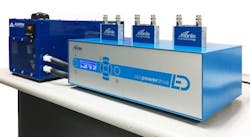Sometimes LEDs need to be water-cooled, too
While LEDs are commonly thought of as devices simply cooled by ambient air, maybe with the addition of cooling fins, this is not always so.
Honle UV (Marlboro, MA and Gräfelfing, Germany), produces industrial UV LED light sources for UV curing of adhesives and coatings, drying, disinfection, and other uses. For example, the company's LED Powerline LC, which is available with wavelengths of 365, 385, 395, or 405 nm, produces, using the 395 nm source as an example, 25 mW/cm2 over either a 76 x 10 or 114 x 10 mm clear aperture.
The larger Honle emitter thus has an optical output of about 3 W, even though package size for this emitter is only 124 x 20 x 50 mm—meaning that a good amount of heat is produced in a small volume. As a result, water cooling is a great benefit.
Honle cools its UV LED sources using compact liquid chillers made by Aspen Systems (Marlborough, MA); specifically, the LED Powerline LC is cooled via Aspen Systems' LCS-600, which is powered by 24 Vdc and is based on Aspen’s vapor compression technology using what Aspen says is the world's smallest compressor.
Aspen Systems says that its chillers, which were developed with the aid of funding by the U.S. SBIR program to develop compact cooling systems for soldier cooling in harsh environments, have been deployed around the world for the U.S. military, and are widely used in medical devices, laser systems, and scientific instruments.
Sources:
http://aspensystems.com/cooling-of-high-power-uv-led-systems-for-curing-applications/
https://www.hoenle.de/hoenle.de/pdfs/produktbroschueren/en/led-powerline-lc-powerdrive-e.pdf

John Wallace | Senior Technical Editor (1998-2022)
John Wallace was with Laser Focus World for nearly 25 years, retiring in late June 2022. He obtained a bachelor's degree in mechanical engineering and physics at Rutgers University and a master's in optical engineering at the University of Rochester. Before becoming an editor, John worked as an engineer at RCA, Exxon, Eastman Kodak, and GCA Corporation.
